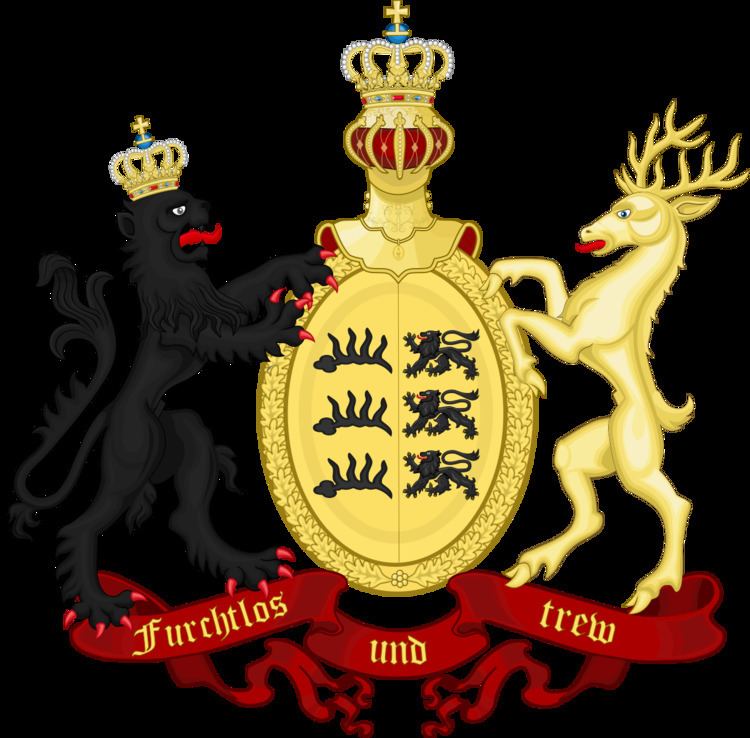Founded 1081 | ||
 | ||
Titles Count of WürttembergDuke of WürttembergElector of WürttembergKing of WürttembergKing of Lithuania Final ruler William II of Württemberg Current head Carl, Duke of Württemberg | ||
The Württemberg family is a European royal family and a German dynasty from Württemberg. The House has its origins, according to recent research, probably in the vicinity of the Salian dynasty.
Contents
History
Around 1080 the ancestors of modern Württemberg, which was then called "Wirtemberg", settled in the Stuttgart area. Conrad of Württemberg became heir to the House of Beutelsbach and built the Wirtemberg Castle. Around 1089, he was made Count. Their domains, initially only the immediate surroundings of the castle included, increased steadily, mainly through acquisitions such as those from impoverished homes of Tübingen.
At the Diet of Worms in 1495, Count Eberhard V was raised to Duke (Herzog) by the German King, later Holy Roman Emperor, Maximilian I. During 1534 to 1537 Duke Ulrich introduced the Protestant Reformation, and the country became Protestant. Duke Ulrich became head of the local Protestant Church.
In the 18th Century, the Protestant male line became extinct, the Head of the House was succeeded by Duke Charles Alexander a Roman Catholic. Despite having a Catholic royal family, Protestantism survived as the established church, run by a church council composed by members of the nobility of Württemberg. From 1797, with the accession of Duke Frederick II, the royal family was again Protestant.
Kingdom of Württemberg
Due to the political upheavals during the reign of Napoleon I, and being an ally of Napoleon, Württemberg became a part of the Confederation of the Rhine, Duke Frederick II was made Elector in May 1803, he collected and received secularized and mediated dominions, which greatly enlarged his country in territorial extension. In January 1806 he was made King of Württemberg.
In 1828 King William I adopted a new house law, the rights and obligations of the ruling family have been established, including the exclusive primogeniture in the male line as well as marriage restrictions on coequal level.
In 1867 the House created the Royal Dukedom of Urach for a younger cousin, Prince Wilhelm, 1st Duke of Urach, whose parents had married morganatically in 1800, whereby their sons were excluded from ruling the kingdom. In 1871 the Royal Dukedom of Teck was created for the same dynastic reason for Francis, Duke of Teck.
At the end of World War I during the German Revolution all the monarchies in Germany were abolished, King William II abdicated on 30 November 1918. When former King William II died in 1921 the senior branch line of the House of Württemberg became extinct, the headship of the House passed to a distant relative, Albrecht, Duke of Württemberg.
Heads of the House of Württemberg since 1918
The legal line of succession of the house of Württemberg has continued to the present, although the house no longer plays any political role. For later rulers, see List of Ministers-President of Württemberg.
The former royal family still owns the castles Monrepos, Altshausen and Friedrichshafen.
Branches of the House of Württemberg
All branches descend from Frederick II Eugene, Duke of Württemberg (1732–1797) on the basis of Agnatic primogeniture
Through the marriages of its female members, many royal families, descend from any of the Württemberg branches. Royal houses include: Bourbon, Liechtenstein, Orléans, Windsor, Wied-Neuwied, etc.
